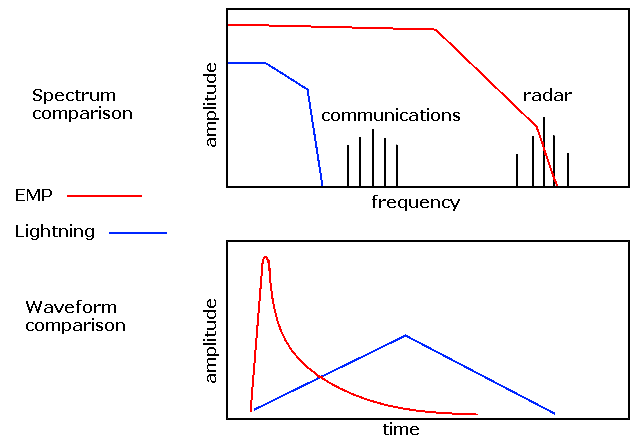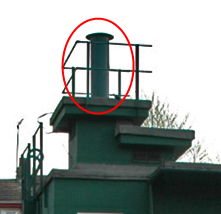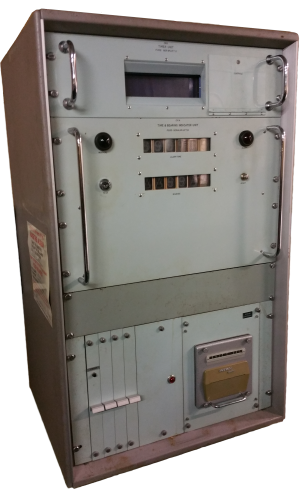Electromagnetic Pulse (EMP)
Despite what you may read elsewhere, the fact that an electromagnetic pulse is produced by a nuclear explosion was known in the earliest days of nuclear weapons testing. In fact conventional explosions also cause an electromagnetic pulse, although it is much smaller. The magnitude of the effects were not known, however. During the Trinity test on 16 July 1945, electronic equipment was shielded due to Enrico Fermi's expectation of the electromagnetic pulse. The official technical history for that first nuclear test states, "All signal lines were completely shielded, in many cases doubly shielded. In spite of this many records were lost because of spurious pickup at the time of the explosion that paralyzed the recording equipment." During British nuclear testing in 1952-1953 instrumentation failures were thought to be due to "radioflash", which was their term for EMP. The first openly reported observation of the unique aspects of high-altitude nuclear EMP occurred following the high altitude, 85,000ft - (26.21km) Yucca nuclear test of the Hardtack I series on 28 April 1958. The test was of a small (1.7 kiloton) weapon and EMP measuring instruments went off their scales. The Yucca EMP was initially positive-going whereas low-altitude bursts were negative pulses and the polarization of the EMP signal was horizontal, whereas low-altitude nuclear EMP was vertically polarized. Later tests confirmed these findings. EMP is dangerous because it has far-reaching effects at distances where other nuclear environments are either nonexistent or inconsequential and because of its high level of broad spectral energy. Significant EMP levels can occur at the Earth's surface out to the tangent radius, at low frequencies (below 100kHz) this range is considerably greater. The tangent radius is where the line of sight from the burst is tangent with the Earth's surface. If one assumes a spherical Earth of radius of 6371 kilometres, a height of burst (HOB) of 100 kilometres gives a tangent radius of 1120 kilometres, and a HOB of 500 kilometres corresponds to a tangent radius of 2450 kilometres. A detonation at 100 kilometres would affect the whole of Europe, even a moderately sized weapon, say 100 kT would have a significant effect over the whole of the area.The causes of EMP
Prompt gamma rays following the nuclear detonation are the principal cause of EMP. This gamma radiation causes bursts of electron flow by the Compton effect, a photoelectric effect, and a "pair production" effect. The collision of gamma rays with atoms and molecules in the atmosphere knocks electrons free of the air molecules and causes the electrons to move rapidly away from the center of the explosion and from the now positively charged parent air molecules. At high altitudes, above 30 kilometers, the atmosphere is thin and this allows gamma radiation from the nuclear burst to travel out radially for large distances, however. the atmospheric density increases as the Earth's surface is approached. The prompt gamma rays propagate toward the Earth in a thin spherical shell, moving at the speed of light away from the detonation. When the downward directed rays encounter the upper regions oi the atmosphere, they begin to interact with the atoms or molecules of the atmosphere at a rate which is a function of atmospheric density and burst conditions. The dominant interaction is Compton scattering, in which the energy of a gamma ray is partially transferred to an electron of an air atom or molecule. The electron then begins traveling in approximately the same direction as the gamma ray.The other product of collision is a gamma ray of reduced energy. The spherical shell of gamma rays is converted during Compton scattering into a spherical shell of accelerated electrons. At the same timer positive ions are formed. The separation of electrons and positive ions produces an electric field. The flow of electrons constitutes a current which radiates electromagnetic energy, providing some asymmetry exists. The energy contained in EMP is similar to that in EM waves generated by a lightning strike, but the high frequency energy content in EMP is a much larger fraction of the total pulse energy.
The relative importance of all nuclear weapons effects, including EMP, depends on weapon characteristics, burst point, and position of the system of interest. Emphasis in this page will be the EMF fields generated by a high altitude burst and some discussion about surface bursts.
Source Region
For both the high altitude and surface bursts, intense fields appear in what is called the source region. The source region for a surface burst is limited to about a two to ten kilometers diameter around the burst. For a high altitude burst, the source region can be on the order of 3000 kilometers in diameter. This source region extends from about 20 to 40 kilometers in altitude. In the source region, weapon effects other than EMF must also be considered. The size of the source region is severely confined by the atmosphere for an atmospheric burst.Beyond the Source Region
Somewhat less intense fields exist beyond the source regions. Additional mechanisms radiate the energy of the source fields well beyond the source regions. In the case of a near surface burst, the net charge separation caused by asymmetry of the source region contributes to the more distant radiated fields. In a detonation outside the atmosphere burst, the earth's magnetic field bends the scattered electron current moving away from the burst point. This bending produces an efficient conversion of the energy of the moving electrons into a radiated electromagnetic pulse in the radio spectrum. This radiation is propagated from the source region onto the surface of the earth. In the case of a high-altitude burst, a significant overpressure pulse does not exist near the surface of the earth. Almost all of the other prompt weapon effects are diminished by the atmosphere, so that the most significant prompt weapon effect is the EMP. As noted previously, the source region can be quite large, in the order of 1,000 miles in diameter. As a consequence, the radiated fields from this source region can cover a substantial fraction of the earth's surface. A single detonation could affect the whole of Europe, or North America.Characteristics of the Nuclear Electromagnetic Pulse (NEMP)
Nuclear EMP produces a characteristic
multi-pulse, usually described in terms of three components, as
defined by the International Electrotechnical Commission (IEC). The
three components are defined by the IEC, as "E1", "E2" and "E3".
Only the first two components of the EMP are used in the detection of nuclear detonations by such systems as AWDREY. Lightning EMP produces radio frequencies which are narrower in bandwidth then nuclear EMP. The pulse is also evident as a double pulse in the visible light spectrum.
E1
The E1 pulse is a very fast component
of nuclear EMP. E1 is a brief but intense electromagnetic field that
induces high voltages in electrical conductors. The E1 pulse can
destroy computers and communications equipment and it changes too
quickly for ordinary surge protection precautions to be effective,
although there are special fast-acting surge protectors that will
block the E1 pulse. The pulse reaches its maximum in about 5
nanoseconds, and decays to half the peak value in 200 nanoseconds
and decays to zero by 1,000 nanoseconds
E1
is produced when gamma radiation from the nuclear detonation
ionizes (strips electrons from) atoms in the upper
atmosphere. This makes the
electrons radiate EMP over a massive area. Because of the curvature
and downward tilt of Earth's magnetic field over the USA, the
maximum EMP occurs south of the detonation and the minimum occurs to
the north. This
is known as the Compton effect and the resulting current is called
the "Compton current". The electrons travel in a generally downward
direction at relativistic speeds (more than 90 percent of the speed
of light). In the absence of a magnetic field, this would produce a
large, vertical pulse of electric current over the entire affected
area. The Earth's magnetic field deflects the electron flow at a
right angle to the field. This interaction produces a very large,
but very brief, electromagnetic pulse over the affected area.
The
EMP pulse peaks at about 50,000 volts per metre art ground level, with
a peak power density of 6.6 megawatts per square metre.
E2
The E2 component is generated by
scattered gamma rays and inelastic gammas produced by neutrons. This
E2 component is an "intermediate time" pulse that, by the IEC
definition, lasts from about 1 microsecond to 1 second after the
explosion. E2 has many similarities to lightning, although
lightning-induced E2 may be considerably larger than a nuclear E2.
Because of the similarities and the widespread use of lightning
protection technology, E2 is generally considered to be the easiest
to protect against.
Only the first two components of the EMP are used in the detection of nuclear detonations by such systems as AWDREY. Lightning EMP produces radio frequencies which are narrower in bandwidth then nuclear EMP. The pulse is also evident as a double pulse in the visible light spectrum.
E3
The E3 component is very different from
E1 and E2. E3 is a very slow pulse, lasting tens to hundreds of
seconds. It is caused by the nuclear detonation's temporary
distortion of the Earth's magnetic field. The E3 component has
similarities to a geomagnetic storm caused by a solar flare. Like a
geomagnetic storm, E3 can produce geomagnetically induced currents
in long electrical conductors, such as telephone lines, and power
distribution line, damaging components such as transformers.
Because of the similarity between solar-induced geomagnetic storms
and nuclear E3, it has become common to refer to solar-induced
geomagnetic storms as "solar EMP." "Solar EMP", however, does not
include an E1 or E2 component.
Deposition zone or region
The region in which Compton scattering occurs is called the deposition region. The thickness and surface range of the deposition region is a function of height-of-hurst (HOB) and weapon size and type. A representative thickness is from 20 kilometres to 40 kilometres, but a deposition region may be as thick as 70 kilometres for a 300 kilometre HOB and a 10 Mt weapon. In the spherical shell of Compton electrons, the electrons are charged particles that rotate spirally around the Earth's geomagnetic field lines. The electrons thus have a velocity component transverse to the direction of the gamma radiation. These transverse currents give rise to a radiating magnetic field. This field propagates through the atmosphere to the surface of the Earth's surface, as if it were contained in the same spherical shell as that termed by the original gamma ray shell.Radiating magnetic field.
In the spherical shell of
Compton electrons, the electrons are charged particles that
rotate spirally around the Earth's geomagnetic field lines. The
electrons thus have a velocity component transverse to the
direction of the gamma radiation. These transverse currents give
rise to a radiating magnetic field. This propagates through the
atmosphere to the Earth's surface as if it were contained in the
same spherical shell as that formed by the original gamma ray
shell.
Effects of EMP
The magnitude of the EMP can
be of the order of 100kV/metre, a thousand times more than that
of a typical radar beam, known to cause sterility and blindness
in humans, but the EMP is of extremely short duration, of the
order of nanoseconds to seconds, however the effects may last
for a protracted period, even up to years.
Other forms of EMP include magnetohydrodynamic (MHD-EMP) which can induce near-D,C, currents in very long conducting structures, such as telephone lines, overhead power cables and the like. Low altitude detonations can produce intense effects over distances of several kilometres. These latter are generally not of great significance except for command, control and communications (C3).
Nuclear EMP induces electric currents in all metallic objects. which by accident or design act as antennas. Aerial and buried power and telecommunication networks in particular can collect considerable amounts of energy in the form of electromotive force (emf). Even short radio antennas and other electrical lines may experience unusual induced currents and voltages. The collected EMF energy could disturb, breakdown, or burn out susceptible electrical and electronic components. Modern solid-state electronics are far more susceptible to stray emf than older valve (tube) based technology, but even they are not immune. In fact systems that are purely electrical, rather than electronic are susceptible to high energy emf pulses. ln 1958 and 1962, high-altitude nuclear tests were carried out by the United States over the Pacific Ocean. During these, some electrical and electronic systems suffered functional damage or operational malfunctions, even hundreds of kilometers from the test sites. It is unlikely that EMP would incapacitate all of the exposed communication systems, power networks, and electronic equipment. However, a small number of failures distributed through a large and complex system can disrupt the entire system, or degrade its stability and performance.EMP could, in fact it is
likely, create confusion and isolation at precisely the time
when critical decisions would have to be made regarding the use
of nuclear weapons. Communications among diplomats, political
leaders, and military commanders could he disrupted. EMP could
also degrade sophisticated military command, control,
communication and intelligence (C3I) systems within minutes of
the ?rst detonations. Such effects could hinder a military
response and might encourage looser control over nuclear weapons
in the field. Because telecommunications would play an important
role in national and international crisis management, any major
disruption of communication networks could affect the course of
a nuclear con?ict.
One of the paradoxes of the
problems caused by EMP is that modern electronics are far more
at risk than older valve (tube) based equipment, due to the
physical differences between solid-state components and
thermionic devices.
EMP Conspiracy Theories
Most of the literature on EMP
is either still classified or not readily available to the
public. A good deal of what is available, chiefly from the
Internet varies considerably in veracity, and much has major
inaccuracies. Some of what you will find uses the right words,
but with inaccurate interpretations. Based upon a 2010 technical
report produced by the Oak Ridge National Laboratory, the
following are the most common myths.
A 2010 technical report written for the US government's Oak
Ridge National Laboratory included a brief section
addressing common EMP myths. This section is a direct quotation
from that Oak Ridge report regarding common HEMP Myths:
- Extremists: Some general emphasis of comments fall into either �the world as we know it will come to an end� if there is a high altitude nuclear burst, or the other extreme: �it�s not a big deal, nothing much will happen�. Since we really have never had a nuclear burst over anything like our current modern infrastructure, no one really knows for sure what would happen, but both extremes are not very believable.
- Yield: There appears to be an assumption that yield is important � it is not for E1. The assumption that E1 is an issue only for cold war type situations, but not for terrorists or rogue nations, is false. Very big bombs might have better area coverage of high fields by going to higher burst heights, but for peak fields the burst yield is only a very minor consideration.
- 1962 experience: Some
point to the Starfish event, and the rather minor HEMP effects
produced at Hawaii by it. However, there are many problems with
extrapolating that experience:
- That was about half a century ago. Since then, the use of electronics has increased greatly, and the type of sensitive electronics we currently use did not really exist back then.
- The burst was fairly far away from Hawaii, and the incident E1 HEMP was much less than worse case.
- The
island is small � if over the continental U.S., long
transmission lines would be exposed (especially an issue for
late-time HEMP). In addition, widely separated substations
would have been exposed, although with electro-mechanical
relays (not solid state). Also the yield argument has been
used � Starfish was a very big weapon, yet it did very
little � see the previous item, yield is not really very
significant.
- Cars dying: Some say
that all vehicles traveling will come to a halt, with all modern
vehicles damaged because of their use of modern electronics (and
one movie even had a bulk, non-electronic part dying). Most likely
there will be some vehicles affected, but probably just a small
fraction of them (although this could create traffic jams in large
cities). A car does not have very long cabling to act as antennas,
and there is some protection from metallic construction. As
non-metallic materials are used more and more in the future to
decrease weight and increase fuel efficiency, this advantage may
disappear. Electric vehicles, with their complex electronics may
be more susceptible to damage, or short-term issues.
- Wristwatch dying: One movie critic pointed out that electronics in a helicopter were affected, but not the star�s electronic watch. A watch is much too small for HEMP to affect it.
- Electrons present: One critic, with some awareness of the generation process, said that HEMP could not be present unless there were also energetic electrons present. This is true when one is within the source region, which exists for all types of EMP � there are energetic electrons present. However for the HEMP, the radiation and energetic electrons are present at altitudes of 20 to 40 km, not at the ground.
- Turn equipment off: There is truth to this recommendation (if there were a way to know that a burst was about to happen). Equipment is more vulnerable if it is operating, because some failure modes involving E1 HEMP trigger the system�s energy to damage itself. However, damage can also happen, but not as easily, to systems that are turned off.
- Maximum conductor length: There is a suggestion that equipment will be OK if all connected conductors are less than a specific length. Certainly shorter lengths are generally better, but there is no magic length value, with shorter always being better and longer not. Coupling is much too complex for such a blanket statement � instead it should be �the shorter the better, in general�. (There can be exceptions, such as resonance effects, which depend on line lengths.)
- Stay away from metal: There is a recommendation to be some distance away from any metal when a HEMP event occurs (assuming there was warning), because very high voltages could be generated. Metal can collect E1 HEMP energy, and easily generate high voltages. However, the �skin effect� (a term not really derived from the skin of humans or any other animal) means that if a human were touching a large �antenna� during an E1 HEMP event, any current flow would not penetrate into the body. Generally E1 HEMP is considered harmless for human bodies.
AWDREY
Atomic Weapons Detection
Recognition and Estimation of Yield known by the acronym AWDREY was
a desk-mounted automatic detection instrument, located at 13 of the
25 Royal Observer Corps (ROC) controls,
across the United Kingdom, during the Cold War. The instruments
would have detected any nuclear explosions and indicated the
estimated size in megatons.
The detection assembly was mounted on the roof of controls, and the signals feds by a number of co-axial cables to an electronics processing unit, in an RF shielded room (Faraday cage). From thence cables fed the processed signals to the display unit. The detector head comprised a short whip antenna and two sets of five photocells to record the double intense light flash of a detonation and the double RF pulse. These double pulses are characteristic of a nuclear explosion and do not occur in the case of lightning. The duration, intensity and the gap between pulses enables an estimate of weapon power. The ring of photocells enable a direction to be determined.
AWDREY was designed, built and maintained by the Atomic Weapons Establishment at Aldermaston. The design was tested for performance and accuracy using real nuclear explosions at the 1957 Kiritimati (or Christmas Island) nuclear weapon trials, after being mounted on board a ship.
During the early phase of
operations, a spare observer was required to stand next to the
display unit and monitor it constantly to identify initial
responses. Once a nuclear strike on the UK had been confirmed by the
Director UKWMO (or his deputy), readings from AWDREY were ignored
during subsequent nuclear bursts within the attack, and the readings
from ROC posts became the main method of detecting and identifying
any subsequent near ground bursts.
The 13 ROC AWDREY units were
located at the group controls in Exeter, Oxford, Horsham, Bristol,
Colchester, Carmarthen, Coventry, Carlisle, York, Dundee, Oban,
Inverness and Belfast. This siting pattern provided sufficient
detectors that the entire UK was covered, but the units were far
enough apart that a lightning storm would be unlikely to trigger
simultaneous AWDREY responses at two sites.
The system was tested daily during operations, using a modified electronic camera flashgun.
Upon triggering of AWDREY, an officer would make an immediate report of the "confidence" of the report, and the codeword "TOCSIN BANG" would be sent to the UKWMO HQ in the form: "TOCSIN BANG � HOR � 1456 � 4 megatons" (Codeword, location of AWDREY in this case Horsham, the time in UTC and the estimated power).






